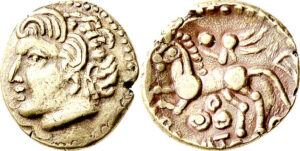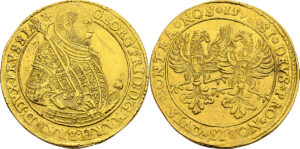Peus Offering Unique Coins and Collections
Dr. Busso Peus Nachf. starts Auction 425 on 7 November 2019 with a collection of Celtic coins that documents this fascinating collection area, from the British Isles to Asia Minor. Among them are rare Eastern Celtic silver coins (e.g. no. 169, a “Wangenschnecke” type tetradrachm and a IANTVMARVS hexadrachm, no. 155) as well as significant gold pieces.

For example, the pale gold stater of the Baiocassi, coming from the Prankerd collection auctioned at Sotheby’s in 1909, is the best preserved specimen of this rare type of coin (no. 32). This can also be said of the very rare ABVCAT stater of the Bituriges Cubi (no. 35). Further pieces of this collection which was acquired in the years 1977-1985 and since then remained untouched combine high quality and collection history.

A fine collection of 72 gold coins has been integrated into the Greek section, which is difficult to surpass in terms of conservation and provenance. Thus, the exquisite Kyrenian gold tetrobole from the time of Magas comes from the collection of the eminent Danish politician Gustav Philipsen, which was auctioned in 1909 by Jacob Hirsch (no. 369). The 1 1/3 litra piece by Gela comes from the 1921 auction of the collection of the important numismatist Pozzi (no. 219), and the massive Mnaieion Ptolemy II with double portraits on both sides is one of the few pieces of this type already in trade before 1970 (no. 358). The Aurum Graecum collection is also of scientific importance, as it contains unica of the Seleucid kingdom. The stater of Antiochus II of the Houghton Collection (no. 303) is the only known specimen of this type, which is also the case for the Stater of Alexander I, which was coined from the drachm dies of Ekbatana (no. 311). Even in silver, the offer of Greek coins is rich. Thus, the early-classic stater of Kaunos is the earliest copy documented by Konuk and possesses a sonorous provenance (no. 290). The tetradrachm of Barke shines with an extraordinary quality for this rare type (no. 362).
The prelude to the Roman section is a special collection of Republican bronze coins of high type density and numerous rarities. Among the Aes Grave, the exceptionally well-preserved As with recognizable value marks on both sides (No. 384) is to be emphasized. In addition, there are some particularly rare pieces that are missing even in the most important private collections of republics that have been auctioned in recent decades (no. 547, Triens of Metellus Caprarius; no. 546, Dodrans of C. Cassius).
The section of the Roman Empire was essentially composed of two major collections, with a focus on rarity and quality (no. 680, Denarius of Didius Julianus; no. 706, Solidus of Constans II). The more common pieces from these collections will be on sale in the next e-auction (18, January 2020), along with other bronzes from the Roman Republic. In addition to the wide selection of Byzantine gold coins, the migration period must be mentioned. Among the 20 or so coins are some rarities, such as a Franconian gold bracteate (no. 793) and rare coins of the Merovingians.

As usual the part of the world coins starts with an offer of coins and medals from abroad and the Habsburg monarchy, with several Thalers from Transylvania. This is followed by the first highlights, a beautiful Judaica collection, as well as a well-kept and tastefully compiled collection of southern German and northern Swiss bracteates and uniface pennies, some of which are exceedingly rare. Since collecting of bracteates, due to the lack of English-language numismatic literature, has so far been limited predominantly to the German-speaking collectors market, it is particularly welcome that Professor Dr. Roger Svensson recently closed this gap to some extent in his book “Renovatio Monetae”, published in the English language. Several of the bracteates have already been presented to an international audience by this basic work.

In the further course of the auction a remarkable series of early Brandenburg-Prussian Thalers follows. In addition, a 10-fold ducat from Georg Friedrich of Brandenburg-Franconia on his administrative dignity in the Duchy of Prussia, stands out. Also in the further course of the auction, small but pretty series of Magdeburg and Schwarzburg are formed. Among the latter, a very rare Thaler from 1570, which is missing both in Fischer and Bethe’s description of the Rudolstadt Palace Museum Collection is particularly worth mentioning. The old German coins are followed by the German Imperial coins and many lowly estimated combined lots. Numismatic literature, mostly in convolutes, closes the auction. The possibility of live bidding via the Internet is given again.
All information, the time table and the online catalogue are available on the Dr. Busso Peus Nachf. website.





